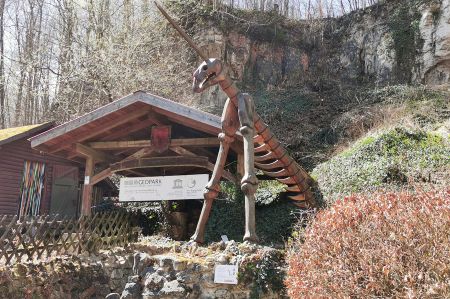Riding the e-bike to the Unicorn Cave near Scharzfeld
- Written by Portal Editor
Today is supposed to be the day, because our goal is the unicorn cave near Scharzfeld, which we had already hiked to, but then came across closed doors.
The starting point is not, as with the Steinkirche hike near Scharzfeld, but Prahljust campsite near Clausthal-Zellerfeld, a tour of around 31 kilometres, initially mostly downhill. So it was important to save battery energy, because we had to go back, but then uphill.
Drive to Unicorn Cave - downhill from Camping Prahljust
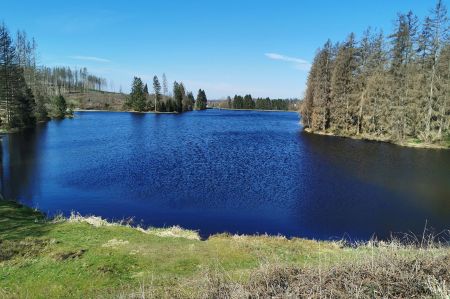 Through the remaining "rest of the forest" we first went past the Ziegenberger pond, along the Lerbach to Friedrich-Ebert-Straße, which runs almost parallel to Landstraße 214 and therefore shows hardly any traffic.
Through the remaining "rest of the forest" we first went past the Ziegenberger pond, along the Lerbach to Friedrich-Ebert-Straße, which runs almost parallel to Landstraße 214 and therefore shows hardly any traffic.
We come across the 214, used it to cross it and then turned into the so-called main street of Osterrode. Already on the way it becomes clear that we will choose a different route for the way back, even if it will be more strenuous. We leave Osterrode on the Herzberger Landstraße, which runs almost parallel to the busy 243 and reach Herzberg am Harz after about 95 minutes driving time.
Now it's uphill again to the unicorn cave, where we can see the dolomite rocks of the stone church again from afar.
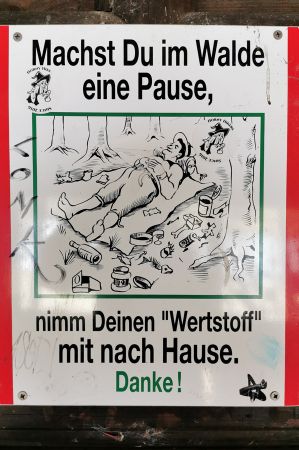 The legendary cave "Unicorn Cave" is almost 700 meters long, of which around 300 meters are shown during the guided tours. According to recent investigations and information from our cave guide through georadar measurements and drilling, the cave is far longer than the previously known parts that can be visited. Several halls and domes are lined up in the cave, which are connected by lower passages, which leads to exciting explanations from the cave guide at the stopping points. The cavity of the cave is up to 50 meters high, but mostly filled with sediments between 15 and 30 meters thick, as is plausibly explained to us. The sediments entered the cave naturally during the ice ages.
The legendary cave "Unicorn Cave" is almost 700 meters long, of which around 300 meters are shown during the guided tours. According to recent investigations and information from our cave guide through georadar measurements and drilling, the cave is far longer than the previously known parts that can be visited. Several halls and domes are lined up in the cave, which are connected by lower passages, which leads to exciting explanations from the cave guide at the stopping points. The cavity of the cave is up to 50 meters high, but mostly filled with sediments between 15 and 30 meters thick, as is plausibly explained to us. The sediments entered the cave naturally during the ice ages.
The entrance is formed by two ceiling collapses in the southwest in the area of the Blue Grotto, through which the cave has also been entered over the last few centuries. In 1895, a 12- meter-long tunnel was created in the northwest of the cave as a new entrance, which opens into the white hall of the Löns tunnel and has since been the lockable main entrance to the cave.
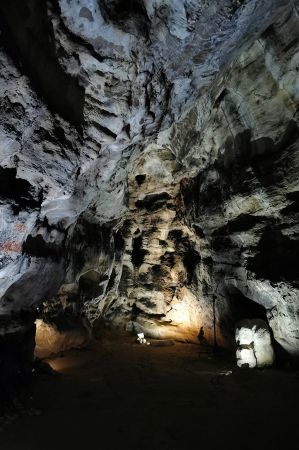 The layers of sediment inside the cave are explained to us as a geological and paleontological research archive, containing large numbers of skeletal remains of animals that have died inside since the Ice Age, as well as being dragged in by predators or humans, and which have only been partially excavated to date.
The layers of sediment inside the cave are explained to us as a geological and paleontological research archive, containing large numbers of skeletal remains of animals that have died inside since the Ice Age, as well as being dragged in by predators or humans, and which have only been partially excavated to date.
So far, over 70 animal species have been scientifically identified on the basis of the numerous bone finds, including 60 mammal species such as cave bears, cave lions and wolves. In the cave there are favourable conditions for the preservation of bone material due to its year-round low average temperature.
Also because of the chemical soil composition of calcareous material there is no demineralization of the bones.
Cave tourism and wall inscriptions in the halls
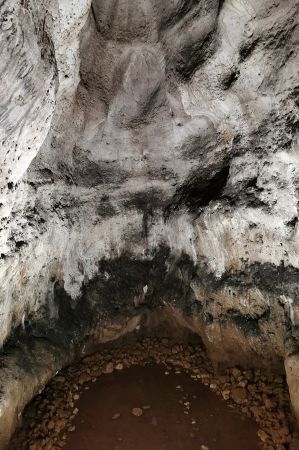 Already in modern times, cave tourism began, in which dukes and kings also participated. Many of these "significant" cave tourists, including celebrities, left their names inscribed on the cave walls, which still exist today and are pointed out with a certain pride. In 1895, an approximately 12-meter-long tunnel was excavated, which enabled access to the White Hall from the outside.
Already in modern times, cave tourism began, in which dukes and kings also participated. Many of these "significant" cave tourists, including celebrities, left their names inscribed on the cave walls, which still exist today and are pointed out with a certain pride. In 1895, an approximately 12-meter-long tunnel was excavated, which enabled access to the White Hall from the outside.
The entrance, now called Löns-Stollen, was probably created by a brewery owner who had leased the cave from the municipality and used it as a beer cellar from 1895 to 1903. After that, a Scharzfeld hotelier leased the cave and organized cave tours for his guests. In 1908, the Harz Club branch club Scharzfeld leased the cave and presented it to the public through its own cave guides. In 1948, the association built a small cottage in front of the cave entrance as a lounge and sales room as well as a forest restaurant. In 2001, Harz Club stopped running the cave.
House Einhorn, stamp office and legends
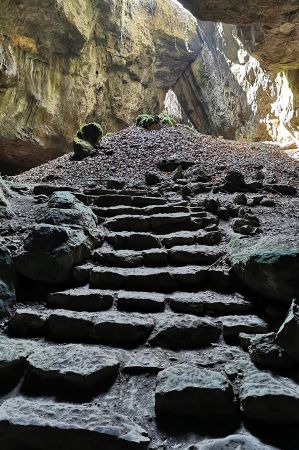 In 2004, the "House Einhorn" was built at today's visitor entrance. It is a gastronomically managed building, which also houses a cave museum and one of the three information centres of the Geopark Harz - Braunschweiger Land - Ostfalen. At the Baude there is also the stamping point no. 101 of the Harzer hiking nobility, which we have already used.
In 2004, the "House Einhorn" was built at today's visitor entrance. It is a gastronomically managed building, which also houses a cave museum and one of the three information centres of the Geopark Harz - Braunschweiger Land - Ostfalen. At the Baude there is also the stamping point no. 101 of the Harzer hiking nobility, which we have already used.
Our cave guide also talks about the legend and points to various depictions: According to a legend, the discovery of the cave is connected with the nearby Scharzfeld stone church. In pagan times, a wise old woman lived in the cave-like stone church and helped those seeking advice. One day she chased away a monk in a black robe accompanied by Frankish warriors. A unicorn is said to have protected her from her pursuers. The woman joined the witches' community on the Brocken's witches' dance floor. After that, the black monk disappeared into a hole in the ground, which led to the discovery of the unicorn cave.
Return via forest and forest paths to the Knollen tower
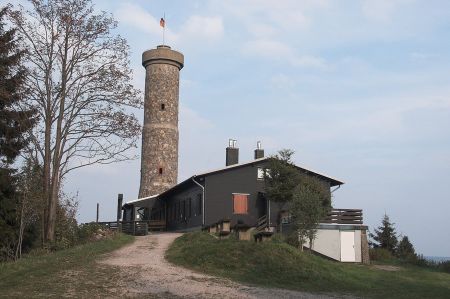 As already mentioned, we want to try the way back via forest roads, despite knowing that it is mostly uphill and we have not yet explored this route. The navigation first leads us to the Göttinger Hütte and then to the Scharzfelder Hütte, mostly parallel to the course of the Bremke, a small creek. A little later we reached Großer Knollen, which is located on the Harzer Baudensteig and is included as number 150 in the system of stamping points of the Harzer hiking nobility. We decide to take a short rest, also to find out more about the "Knollenturm" lookout tower.
As already mentioned, we want to try the way back via forest roads, despite knowing that it is mostly uphill and we have not yet explored this route. The navigation first leads us to the Göttinger Hütte and then to the Scharzfelder Hütte, mostly parallel to the course of the Bremke, a small creek. A little later we reached Großer Knollen, which is located on the Harzer Baudensteig and is included as number 150 in the system of stamping points of the Harzer hiking nobility. We decide to take a short rest, also to find out more about the "Knollenturm" lookout tower.
From the 20 m high observation tower Knollenturm, built in 1904, which stands together with the Knollenbaude inn on the summit of the Großer Knollen, you can see not only the mountains of the Harz Mountains, but also the Rotenberg and Eichsfeld to the south. In this direction you can even see the Großer Inselsberg in the Thuringian Forest when visibility is good.
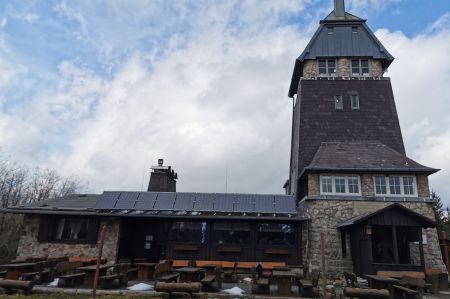 There are numerous hiking trails from its summit, according to the Baudenwirt, including to Bad Lauterberg, Herzberg, Scharzfeld, Sieber and Sankt Andreasberg. The approximately 12 km long path to Sankt Andreasberg runs on a mountain ridge more than 600 m high with many beautiful views.
There are numerous hiking trails from its summit, according to the Baudenwirt, including to Bad Lauterberg, Herzberg, Scharzfeld, Sieber and Sankt Andreasberg. The approximately 12 km long path to Sankt Andreasberg runs on a mountain ridge more than 600 m high with many beautiful views.
We continue on our way and shortly afterwards reach the village of Sieber and then follow the forest path in the direction of Hanskuehnenburg, a climb that is sometimes quite steep, which puts a corresponding strain on our e-bikes. At first we thought of going to the Hanskuehnenburg as well, but at the junction we decide to go back to the Magdeburger Hütte directly on the B 242, which then takes us back to the campsite. A good decision, because a little later the battery is empty, too much use, especially on the Sieber - Hanskuehnenburg section.
Please read as well:
Hike Bastei Bridge - starting point Rathen an der Elbe
Tour through the Kelmend into the Cem Gorge
-
 E-Bike Tour to Einhornhöhle Scharzfeld
E-Bike Tour to Einhornhöhle Scharzfeld
E-Bike Tour to Einhornhöhle Scharzfeld
E-Bike Tour to Einhornhöhle Scharzfeld
-
 E-Bike Tour to Einhornhöhle Scharzfeld
E-Bike Tour to Einhornhöhle Scharzfeld
E-Bike Tour to Einhornhöhle Scharzfeld
E-Bike Tour to Einhornhöhle Scharzfeld
-
 E-Bike Tour to Einhornhöhle Scharzfeld
E-Bike Tour to Einhornhöhle Scharzfeld
E-Bike Tour to Einhornhöhle Scharzfeld
E-Bike Tour to Einhornhöhle Scharzfeld
-
 E-Bike Tour to Einhornhöhle Scharzfeld
E-Bike Tour to Einhornhöhle Scharzfeld
E-Bike Tour to Einhornhöhle Scharzfeld
E-Bike Tour to Einhornhöhle Scharzfeld
-
 E-Bike Tour to Einhornhöhle Scharzfeld
E-Bike Tour to Einhornhöhle Scharzfeld
E-Bike Tour to Einhornhöhle Scharzfeld
E-Bike Tour to Einhornhöhle Scharzfeld
-
 E-Bike Tour to Einhornhöhle Scharzfeld
E-Bike Tour to Einhornhöhle Scharzfeld
E-Bike Tour to Einhornhöhle Scharzfeld
E-Bike Tour to Einhornhöhle Scharzfeld
-
 E-Bike Tour to Einhornhöhle Scharzfeld
E-Bike Tour to Einhornhöhle Scharzfeld
E-Bike Tour to Einhornhöhle Scharzfeld
E-Bike Tour to Einhornhöhle Scharzfeld
-
 E-Bike Tour to Einhornhöhle Scharzfeld
E-Bike Tour to Einhornhöhle Scharzfeld
E-Bike Tour to Einhornhöhle Scharzfeld
E-Bike Tour to Einhornhöhle Scharzfeld
-
 E-Bike Tour to Einhornhöhle Scharzfeld
E-Bike Tour to Einhornhöhle Scharzfeld
E-Bike Tour to Einhornhöhle Scharzfeld
E-Bike Tour to Einhornhöhle Scharzfeld
-
 E-Bike Tour to Einhornhöhle Scharzfeld
E-Bike Tour to Einhornhöhle Scharzfeld
E-Bike Tour to Einhornhöhle Scharzfeld
E-Bike Tour to Einhornhöhle Scharzfeld
-
 E-Bike Tour to Einhornhöhle Scharzfeld
E-Bike Tour to Einhornhöhle Scharzfeld
E-Bike Tour to Einhornhöhle Scharzfeld
E-Bike Tour to Einhornhöhle Scharzfeld
-
 E-Bike Tour to Einhornhöhle Scharzfeld
E-Bike Tour to Einhornhöhle Scharzfeld
E-Bike Tour to Einhornhöhle Scharzfeld
E-Bike Tour to Einhornhöhle Scharzfeld
https://www.alaturka.info/en/bicycle-travelling-e-bike-camping/6110-with-the-e-bike-to-the-unicorn-cave-near-scharzfeld#sigProId7acae28693
